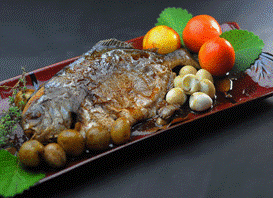FRIED PAMPANO IN “INNOVATED” ADOBO SAUCE
Fried Pampano In Innovated Adobo Sauce
(FRIED SILVER POMFRET IN A DIFFERENT ADOBO SAUCE)
From Spanish word “Adobar” (marinade or seasoning),
“ADOBO” is a type of Filipino cuisine dating back
pre-Spanish colonization of the country.
For preservation, the boiling of meat in water and salt, early folks thought of
adding vinegar into the method to further the shelf life of boiled meat.
To date, no record shows how this prep was called until
Spaniards set foot and introduced soy sauce into the process
stating such marinade was termed “adobar”.
Early cooks liked the result as salt was lessened
and the flavor that soy sauce imparted created a different taste profile.
Cutting short…Adobo came to fore,
went through different regional modifications,
adding poultry, seafood, veggies or combination thereof to the process
and till now-further innovations are continuously tried.
Herewith, Spanish’ Adobar refers to “the marinade” or “seasoning”
hence the “flavoring process”
while Pinoys’ Adobo, in strictest sense, is the “cooking process”.
(FRIED SILVER POMFRET IN A DIFFERENT ADOBO SAUCE)
From Spanish word “Adobar” (marinade or seasoning),
“ADOBO” is a type of Filipino cuisine dating back
pre-Spanish colonization of the country.
For preservation, the boiling of meat in water and salt, early folks thought of
adding vinegar into the method to further the shelf life of boiled meat.
To date, no record shows how this prep was called until
Spaniards set foot and introduced soy sauce into the process
stating such marinade was termed “adobar”.
Early cooks liked the result as salt was lessened
and the flavor that soy sauce imparted created a different taste profile.
Cutting short…Adobo came to fore,
went through different regional modifications,
adding poultry, seafood, veggies or combination thereof to the process
and till now-further innovations are continuously tried.
Herewith, Spanish’ Adobar refers to “the marinade” or “seasoning”
hence the “flavoring process”
while Pinoys’ Adobo, in strictest sense, is the “cooking process”.

Fried Pampano In Innovated Adobo Sauce
| Prep time | Cook time | Total time |
| 30 mins | 30 mins | 1 hour |
Ingredients
- SEA FOOD:
- 1 medium sized Pampano (silver or black pomfret) fully cleaned of internals, pointed fins cut.
- DON’T SLIT sides to prevent skin break up while frying.
- Never mind not salting or peppering it. Full flavor is attained when Adobo sauce is drizzled unto fried fish.
- FRYING NEED:
- 100 ml. palm or soya oil
- DIFFERENT ADOBO SAUCE:
- 20 ml. palm or soya oil for sautéing garlic & bay leaves
- 6 cloves crushed fresh garlic
- 2 dried bay leaves
- 40 ml. oyster sauce (I prefer Lee Kum Kee)
- 10 ml. cane vinegar
- 15 ml. soy sauce (any)
- 60 ml. tap water (should you wish pineapple juice, it’s better)
- 15 grams brown sugar
- 3 grams cracked black pepper
- 2 grams chili powder (this gives a little “kick”-and it is NOT chili pepper powder…it is chili powder which consists of 5-8 ingredients in it)
- OPTIONAL:
- 3 grams MSG
- 5 grams tapioca (cassava) starch dissolved in 15 ml. tap water-sauce thickener
- (I prefer to use tapioca starch, sometimes modified one, as it results to lasting viscosity vs. corn starch.
- ADD-ONS & GARNISH:
- 12 pieces skin-on baby potatoes-fully scrubbed & rinsed skin
- 6-8 pieces quail eggs
- 3 tomatoes-as garnish
- any greens-for colorful eye appeal
Instructions
- Heat oil in frying pan. Carefully throw in a droplet of tap water unto heated oil.
When that drop “rumbles” and “splatters” up and about…your oil is ready.
Fry your fish per your desired done-ness. Cover pan to avoid “oil splatters” everywhere.
When done, scoop fish out and set aside. - Even while frying, you can start your sauce. Heat casserole, add in oil then your crushed garlic and bay leaves.
Tossing consistently, sauté until medium brown. - Pour in water, soy sauce, vinegar, oyster sauce, sugar, cracked pepper, chili powder and the OPTIONAL MSG.
- Add in skin-on baby potatoes and quail eggs and boil.
- After 3 minutes of boiling, quail eggs are done. Scoop out, rinse with cold tap water, de-shell and set aside.
- After another 5 minutes of boiling, your baby potatoes are cooked-but-crunchily done. This time, add in your hard boiled quail eggs.
- Then your tapioca starch-water solution to thicken sauce.
- Continue boiling for 2-3 minutes or until you see good-viscous sauce.
- Lay your fried fish unto plate, garnish and drizzle abundantly with different Adobo sauce.
- Smile as you serve your new creation to family.
DISCLAIMER: Above are test kitchen and household-produced dishes. All ingredients utilized are of food grade quality passing international and domestic sanitary standards. While we find the results highly acceptable, no guarantee nor explicit assurance is hereby issued when recipe is performed by readers. For one, although of similar breed, spices, herbs and other ingredients vary from country to country/region to region that possibility of affecting end taste, aroma & bite-feel is great. Further thereto, mentioned sensory evaluation (aroma, taste, mouth-feel) is subjective.














Leave a Reply
Want to join the discussion?Feel free to contribute!